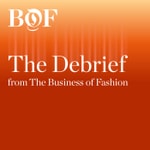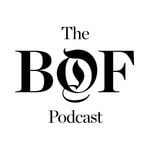The Debrief – Détails, épisodes et analyse
Détails du podcast
Informations techniques et générales issues du flux RSS du podcast.

The Debrief
The Business of Fashion
Fréquence : 1 épisode/14j. Total Éps: 88

Hosted on Acast. See acast.com/privacy for more information.
Classements récents
Dernières positions dans les classements Apple Podcasts et Spotify.
Apple Podcasts
🇨🇦 Canada - fashionAndBeauty
29/07/2025#58🇬🇧 Grande Bretagne - fashionAndBeauty
29/07/2025#15🇩🇪 Allemagne - fashionAndBeauty
29/07/2025#54🇺🇸 États-Unis - fashionAndBeauty
29/07/2025#27🇫🇷 France - fashionAndBeauty
29/07/2025#19🇨🇦 Canada - fashionAndBeauty
28/07/2025#42🇬🇧 Grande Bretagne - fashionAndBeauty
28/07/2025#15🇩🇪 Allemagne - fashionAndBeauty
28/07/2025#43🇺🇸 États-Unis - fashionAndBeauty
28/07/2025#26🇫🇷 France - fashionAndBeauty
28/07/2025#41
Spotify
Aucun classement récent disponible
Liens partagés entre épisodes et podcasts
Liens présents dans les descriptions d'épisodes et autres podcasts les utilisant également.
See allQualité et score du flux RSS
Évaluation technique de la qualité et de la structure du flux RSS.
See allScore global : 53%
Historique des publications
Répartition mensuelle des publications d'épisodes au fil des années.
Kamala Harris and the Politics of Style
vendredi 30 août 2024 • Durée 31:46
As the first female, Black, and South Asian Vice President of the United States, Kamala Harris’s every move is closely watched — from her policy decisions to her wardrobe. With Harris now leading the Democratic ticket in the 2024 presidential election, her style and beauty choices — from her for her sleek silk press hairstyle to her endless variety of pantsuits — have sparked renewed discussion.
“She is communicating something, even if it's not remarkable,” said BoF senior correspondent Sheena Butler-Young. “No one truly opts out of signalling something with how they present themselves.”
This week on The Debrief, BoF executive editor Brian Baskin sat down with Butler-Young and editorial apprentice Yola Mzizi to explore how Harris’s beauty and fashion choices are being interpreted by different audiences across the political spectrum, and what that means for the future of political style.
Key Insights:
- Harris’s signature silk-pressed hairstyle has deep roots. “It's a centuries old way of straightening hair, and it's been around for generations upon generations. Most people associate it with just the hair that they have to have for Easter Sunday, or the style that the grandmothers would have,” Mzizi explains. Despite the history, Black Gen-Z voters have embraced the style, calling it the presidential silk press. “It's a way to support her candidacy in a fun way,” said Mzizi.
- Harris’ wardrobe choices are being closely scrutinised, which has led her to more streamlined, straightforward ensembles. “The pantsuits, specifically the colour schemes — black, grey, navy blue, or just blues, with an occasional pastel, a pump as the shoe, or occasional Converse and pearls — are very much in line with how politicians dress,” said Butler-Young. Meanwhile, male politicians, like Harris’s vice-presidential nominee, Minnesota Governor Tim Walz, have more freedom to experiment. “You look at her running mate Tim Walz, and his ability to sort of play around with style with those well-worn red wing boots, the camouflage hats, rather than being distracting, they actually endear some voters to him. … Kamala, for all intents and purposes, doesn't seem to have the licence to do that.”
- The 2024 election has highlighted the growing role of fashion and beauty in politics. Black-owned beauty brand BLK/OPL was centre stage at the DNC providing makeup services as the event’s first beauty sponsor. “Harris's candidacy is opening up new avenues for different kinds of brands to have their say in this larger conversation,” Mzizi notes.
- Should Harris win the presidency, she could use her platform to further influence the intersection of fashion and politics. Harris has already hinted at this with her past choices by wearing Black designers like Christopher John Rogers and Sergio Hudson. “She'll have more leeway to [support minority designers] when she's empowered. Right now, I think she's constrained … by this idea of having to cater to this broad, collective public palette.”
Additional resources
- How Kamala Harris’ Signature Tresses Became a Gen-Z Hit | BoF
- Why Kamala Harris Isn’t Making Bold Fashion Choices – Yet | BoF
Hosted on Acast. See acast.com/privacy for more information.
How Tweens Took Over the Beauty Aisle
vendredi 23 août 2024 • Durée 33:50
2024 has brought forth the arrival of the “Sephora tweens,” which refers to members of Gen Alpha (roughly defined as those born between 2010 and 2024) who have enthusiastically taken to buying up skincare and makeup. This phenomenon, driven largely by beauty-related chatter on social media, has resulted in a new wave of brands catering specifically to this younger demographic.
“There are now teen brands, tween brands, 20-something brands, 30-something brands. … I think we can thank the DTC movement and everything that happened from 2014 on for this kind of innovation,” Rao says. “There's been a total disruption in beauty overall with challenger brands like Glossier that have come and really taken market share away from the big conglomerates and companies … that have been household names for a really long time.”
This week on The BoF Podcast, senior correspondent Sheena Butler-Young and executive editor Brian Baskin sat down with Priya Rao, executive editor at The Business of Beauty at BoF, to delve into how tweens have taken over the beauty aisle and what this means for the future of the industry.
Key Insights
- Kids have long experimented with beauty products, but today, they’re starting earlier and earlier. "If you look at social media today, it's not just 10-year-olds or 11-year-olds. There are 5- and 6-year-olds putting on makeup and trying different lipsticks and lip glosses," shared Rao. This early engagement with beauty is not just a passing trend, but is becoming a norm, fueled by the accessibility of products to try in stores like Sephora and the influence of social media platforms like TikTok.
- Another driving force behind this trend is the rise of celebrity-led beauty brands that resonate with young people. For example, Rare Beauty, founded by Selena Gomez, not only offers products but also promotes mental health awareness. "Tweens and teens can identify with these brands not just because of the products, but because of what they stand for," explained Rao.
- The proliferation of skincare products has also led to some confusion and concern, with tweens using products like retinol that are meant for an older demographic. Brands and influencers play a crucial role in teaching young consumers what’s right for their skin. "Fear is not the way to lead here. It's about education first," advised Rao. Brands must strike a balance between engaging young consumers without overwhelming them with too many steps or products.
- As the beauty industry continues to evolve, brands that wish to stay ahead will need to be responsive to the needs of Gen-Z and Gen Alpha consumers. "Smart companies have to be agile and constantly communicate with their customers," noted Rao. This means reflecting the diverse experiences of young consumers back to them, whether through representation in ad campaigns or through the products themselves.
Additional resources
- How Tweens Took Over the Beauty Aisle | BoF
- How Should We Feel About Tweens at Sephora? | BoF
- Tweens Obsessed With Skin Care Drive Brands to Say: Don’t Buy Our Stuff
Hosted on Acast. See acast.com/privacy for more information.
Luxury’s Battle With Counterfeiters
mercredi 30 novembre 2022 • Durée 23:43
BoF retail correspondent Cathaleen Chen details the consumer shifts that have made it easier — and more popular than ever — to buy luxury dupes.
Background:
A growing number of young consumers are embracing counterfeit Prada loafers and Gucci bags, as the internet has made access to these dupes easier than ever. The value of the fake and pirated goods market has tripled since 2013 to be worth $3 trillion, according to the Organisation for Economic Co-operation and Development. That’s thanks to a number of factors. For one, websites like Aliexpress and DHgate connect consumers directly with counterfeit manufacturers. It’s no longer a necessity for the dupe-curious shopper to visit the shady alleys of Canal Street. Meanwhile, the skyrocketing prices of luxury products are pushing aspirational shoppers away.
At the same time, the quality of luxury goods has diminished as much production has been outsourced to Asia, narrowing the gap between what’s real and what’s fake. Lastly, social media and constant seasonal trends have conditioned consumers to covet not only the “it” bag of the season but shoes, tank tops and more.
“I think there’s a sense of consumer alienation with luxury goods — where it's like you’re super close to it, but at the same time it's extremely inaccessible,” said retail correspondent Cathaleen Chen.
Key Insights:
- Counterfeits have gotten much easier to find and buy: Chinese websites like DHgate and AliExpress ship inexpensive dupes to Western consumers’ doorsteps.
- The counterfeit surge doesn't seem to be affecting the bottom lines of luxury goods companies, whose profits have only risen in the past few years.
- Resale plays an interesting role in the counterfeit conversation. On the one hand, resale could curb the continued growth of dupes by providing shoppers an entry to luxury pieces. On the other, resale is particularly vulnerable to fakes, as platforms have to be on guard against ever-more-sophisticated fakes.
Additional resources:
- https://www.businessoffashion.com/articles/luxury/fashion-counterfeit-problem-authentication-technology/
- https://www.businessoffashion.com/articles/global-markets/china-luxury-counterfeits-flourish-louis-vuitton-covid-19-douyin-pinduoduo/
Join BoF Professional today with our exclusive podcast listener discount of 25% off an annual membership, follow the link here and enter the coupon code ‘debrief’ at checkout.
Want more from The Business of Fashion? Subscribe to our daily newsletter here.
Follow The Debrief wherever you listen to podcasts.
Hosted on Acast. See acast.com/privacy for more information.
Why So Many Direct-to-Consumer Brands Are for Sale Right Now
mercredi 23 novembre 2022 • Durée 14:01
As the economy weakens and funding dries up, digital brands may face pressure to sell from investors. To do so, they’ll need to prove they’re more than just another money-losing start-up.
Background:
Over the past few years, investors have been bullish on fast-growing digital brands — rewarding their rapid sales growth with sky-high valuations. More recently, physical retail has rebounded and e-commerce sales have shrunk. As a result, a number of digital-first brands are burning through cash as inflation and the cost of goods rises. VCs are increasingly wary of investing in companies without clear paths to profitability, so a number of those money-losing labels are finding it difficult to raise funds. Many, with few options to weather the imminent recession, are looking for an exit.
“A great deal of these digital brands were growing at all costs… people did not anticipate a large slowdown and then a possible recession — so they weren’t managing their money well,” said Malique Morris, BoF direct-to-consumer correspondent.
Key Insights:
- To catch the eye of a potential investor, brands must focus on profitability. But they also need to set themselves apart with new ideas and business models.
- A number of retailers struggling to adapt to shifting consumer tastes — like Victoria’s Secret, which acquired lingerie start-up Adore Me in November — are in need of a boost.
- To set the stage for an attractive exit, Ministry of Supply, which sells wrinkle-free dress shirts, has focused on getting old customers to make additional purchases, rather than acquire new ones.
- Seeing lower valuations, profitable brands that are attractive acquisition targets don’t have much incentive to sell at the moment.
Additional Resources:
- https://www.businessoffashion.com/articles/direct-to-consumer/buck-mason-ministry-of-supply-adore-me-dtc-acquisitions-/
- https://www.businessoffashion.com/articles/entrepreneurship/why-venture-capital-is-a-bad-fit-for-most-fashion-businesses/
- https://www.businessoffashion.com/articles/entrepreneurship/a-new-model-for-funding-fashion-start-ups/
Join BoF Professional today with our exclusive podcast listener discount of 25% off an annual membership, follow the link here and enter the coupon code ‘debrief’ at checkout.
Want more from The Business of Fashion? Subscribe to our daily newsletter here.
Follow The Debrief wherever you listen to podcasts.
Hosted on Acast. See acast.com/privacy for more information.
Fashion’s Gen-Z Obsession
mercredi 16 novembre 2022 • Durée 28:45
The BoF Insights team shares details from their recent report on why these young consumers are so crucial to the success of the fashion industry — and what brands can do to woo them.
Background:
Gen-Z, or those born between 1997 and 2010, accounts for 25 percent of the world’s population. With the oldest of the generation turning 25 this year, the group has already come into its own with a purchasing power of about $360 billion. Fashion brands have always chased youth, but Gen-Z brings a whole new set of marketing challenges. Having grown up in the midst of rapid technological advancement, a worsening climate crisis and global movements like Me Too and Black Lives Matter, Gen-Z has been characterised as more pragmatic and socially aware, while also being trend-fixated. The contradictions are endless.
Key Insights:
- Sometimes, Gen-Z contradicts itself. For example, top fashion brands including Nike and Gucci were among the general group’s favourite brands — but smaller focus groups said they wanted to support underrepresented designers. As well, fast fashion brands like Shein are popular, but the group says they care about sustainability.
- Gen-Zers increasingly impact the economy. However, the group will come into its own with more financial insecurity than those before it.
- BoF Insights distilled the demographic down to a few key personas with distinct characteristics to understand its habits and behaviours: the forgers, signatures, satellites, rebels, explorers and idealists.
- Generally, brands should communicate with Gen-Z in a casual, natural, community-forward way. The group is less beholden to traditional tastemakers, and trends move fast.
BoF Insights is the new data and analysis think tank from The Business of Fashion, arming fashion and luxury professionals with the business intelligence they need to make better strategic decisions. For more insights, please see BoF Insights’ archive on topics like designer bags, resale, digital fashion, and fashion’s supply chain.
Additional resources:
- https://www.businessoffashion.com/reports/retail/gen-z-fashion-in-the-age-of-realism-bof-insights-social-media-report/
- https://www.businessoffashion.com/articles/retail/implications-of-gen-z-for-the-fashion-industry-bof-insights-charts/
- https://www.businessoffashion.com/events/retail/gen-z-and-fashion-in-the-age-of-realism-bof-live-insights-report/
Hosted on Acast. See acast.com/privacy for more information.
The State of the Influencer Economy
mercredi 9 novembre 2022 • Durée 32:13
A panel of experts, including BoF’s Lauren Sherman and Diana Pearl, detail how the business of influencing has evolved — and where it's all going.
Things move fast on the internet. In just the past few years, there have been a number of changes in the social media space and the influencer economy built around it. For one, brands are betting on influencers with day jobs, working with creators like Sky Ting Yoga founder Krissy Jones or James Whiteside, principal dancer at the American Ballet Theatre, as they look for relatable ambassadors to reach engaged audiences. The line between the average social media user and influencer is increasingly blurred as non-influencers endorse products online. Widely, people learn more about brands from other people, rather than brands’ own storytelling. It's becoming even more important for brands to be on every platform — and influencers to have their own platforms.
Key Insights:
- In many ways, the shift represents a return to old days of influence — where hobbyists set up YouTube channels and churned out authentic content viewers found refreshingly relatable.
- Influencer pay increased almost 50 percent overall from 2020 to mid-2021, said Nord. But, there are a lot more influencers getting paid, which means more competition as brands have a deepening pool of options.
- There’s been a shift to video-first content. And younger generations are starting to snag brand deals from more established figures.
- Overall, marketers are paying whether influencers actually have influence — not just followers.
Additional Resources:
- Why You Should Hire an Influencer With a Day Job: Influencers who gained online fame for offline pursuits are rapidly earning brand attention, but working with them requires a different type of partnership.
- Why Nordstrom Appears to Be Pivoting Away From Influencers: Influencers helped turn Nordstrom’s Anniversary Sale into a major moment for the department store. This year, they say the retailer is leaning less on social media marketing, leading some creators to downplay the annual event.
- Is Now the Time to Hire a Virtual Influencer? Virtual influencers had faded from fashion campaigns, but now amid all the metaverse hype they’re popping up again, with Prada and Pacsun turning to virtual faces.
- The Complete Guide to Influencer Marketing: As the creator space has matured, brands must be thoughtful about crafting a strategy that leverages influencer marketing’s full power, considering everything from talent scouting to the effectiveness of metrics.
Hosted on Acast. See acast.com/privacy for more information.
Is Luxury’s Streetwear Obsession Over?
mercredi 2 novembre 2022 • Durée 16:41
Background:
After years of build up, from its origins in cultural movements like New York’s hip-hop scene and LA’s skating community to early commercialisation in the early 2000s from brands like Fubu and Stussy and Japanese designers Nigo and Hiroshi Fujiwara, by the late 2010s, streetwear found itself at the centre of luxury fashion. The breaking point came in 2018, when, after success at his label Off-White, Virgil Abloh was named creative director of Louis Vuitton.
But lately, streetwear institutions like Bape and Stussy have been losing heat — and luxury brands are pivoting away from streetwear staples like hoodies and sneakers.
“Streetwear brands are more commercial and less connected to the actual street culture where they found their roots,” said BoF editorial associate Daniel-Yaw Miller.
Key Insights:
- Streetwear brought items like puffer jackets and hoodies, graffiti details and logo-centric designs to high fashion runways.
- Lately, designers have been more focused on harder shoes, knitwear and tailoring. But, streetwear-centric items haven’t disappeared from brands’ assortments, they’re more absorbed into the core offerings — and in consumers' day-to-day wardrobe.
- A new crop of brands, including Daily Paper, Corteiz and Free The Youth, are making the case for streetwear’s enduring fashion relevance.
- Streetwear mainstay Supreme is still driving growth with its savvy marketing and collaborations. Owner VF Corp. said it expects the label to generate $600 million in revenue this year — up from $500 million when it was acquired in 2020.
Additional Resources:
- Why Supreme Sold to VF Corporation: In a deal that values the New York streetwear brand at $2.1 billion, Supreme picks up a long-term partner with back-end prowess and ambitions to scale it past $1 billion in annual sales.
- Is Streetwear Still Cool? Luxury brands may have pivoted away from sneakers, puffer jackets and hoodies, but new labels like Corteiz and Free The Youth are making a case for street culture’s enduring relevance in fashion.
Join BoF Professional today with our exclusive podcast listener discount of 25% off an annual membership, follow the link here and enter the coupon code ‘debrief’ at checkout.
Want more from The Business of Fashion? Subscribe to our daily newsletter here.
Follow The Debrief wherever you listen to podcasts.
Hosted on Acast. See acast.com/privacy for more information.
What Makes Jacquemus So Successful?
mercredi 26 octobre 2022 • Durée 21:41
Simon Porte Jacquemus is one of fashion’s hottest independent designers — and his namesake label is one of its most impressive businesses. The company, known for its tiny bags and minimalist playfulness, is on track to double annual revenues to over €200 million ($199 million) by year-end, with plans to reach €500 million by 2025. The designer has been able to build buzz with his clear brand vision, and savvy ability to storytell through social media.
“He was one of the first designers to realise how powerful of a tool Instagram was going to be, and to have something really compelling to say on that platform — to have a universe that was just really organically compelling,” said BoF luxury editor Robert Williams.
Key Insights:
- Simon Porte Jacquemus has managed to build a scalable luxury start-up without the help of a conglomerate or big investor: a rarity in fashion. Jacquemus thinks the pressure to up sales every season to keep the business running pushed him to commercial success.
- Armed with a new store on Avenue Montaigne, the brand reaches up into luxury prices, but maintains a more accessible, fun, young and playful bent.
- Handbags — led by the brand’s hit, Chiquito style — are an essential profit driver for the business.
- With a new CEO on board in Puig’s Bastien Daguzan, the brand is looking to solidify its footwear business and diversify its menswear offering.
- As of now, Jacquemus does not plan on taking outside investment. The brand believes it's momentum and strong retail partnerships will help it reach its sales goal of €500 million by 2025.
Additional Resources:
- Jacquemus: A Fashion Star’s Business Vision: For the first-time, the industry’s hottest independent designer — a charismatic, social-media savvy storyteller from the south of France — reveals the financial underpinnings of his burgeoning company and plans for the next phase of growth.
- How to Open a Store in 2022: From seamless online-to-offline offerings to metaverse-inspired installations, the standards of brick-and-mortar retail have evolved since the pandemic struck.
- Jacquemus, Now Nike-Approved, Opens ‘New Era’ in Provence: Simon Porte Jacquemus’ showmanship, social-media savvy and ultra-recognisable designs have turned his regionally-inspired label into a global hit.
Join BoF Professional today with our exclusive podcast listener discount of 25% off an annual membership, follow the link here and enter the coupon code ‘debrief’ at checkout.
Want more from The Business of Fashion? Subscribe to our daily newsletter here.
Follow The Debrief wherever you listen to podcasts.
Hosted on Acast. See acast.com/privacy for more information.
Giorgio Armani, Fashion’s Most Successful Designer
mercredi 19 octobre 2022 • Durée 24:05
BoF editor-at-large Tim Blanks describes the designer and businessman’s life, continuing impact on fashion, mysterious succession plans and newfound vulnerability.
Background
Over his decades-long career, Giorgio Armani has built one of fashion’s most successful businesses. Known for his signature tailoring and functional glamour, at 88, he’s retained his dominance in an ever-changing, hyper-competitive industry. Amid speculation about what's to come for the Armani fashion empire, BoF editor-at-large Tim Blanks met the titan at his garden in Milan for an intimate conversation about his life, business and future — including succession plans.
“He was a revolutionary in his own way. I can think of maybe five people in fashion who had the impact he had,” said Blanks.
Key Insights:
- The Bloomberg Billionaires Index estimates Armani has a personal net worth of $9.5 billion. He still owns and runs his company and as Blanks says, may value his independence more than anything.
- Rumours about Giorgio Armani’s future after Armani include a potential takeover by Bernard Arnault’s LVMH, the Agnelli family’s Exor or Valentino parent Mayhoola.
- One thing people don’t fully realise about Armani is he is an eccentric, said Blanks. Armani told Blanks his eccentricity lies in his radical approach to design, which is both streamlined and nuanced.
- Armani’s close relationship with partner Sergio Galeotti, who passed away in 1985, has helped fuel his ascent to status as fashion’s most successful designer. Now, Armani, who has no children and doesn’t claim many friends outside his family and his company, is leaning into a new kind of love and vulnerability, thanks to the presence of his collaborator’s young daughter at the office.
Additional Resources:
Join BoF Professional today with our exclusive podcast listener discount of 25% off an annual membership, follow the link here and enter the coupon code ‘debrief’ at checkout.
Want more from The Business of Fashion? Subscribe to our daily newsletter here.
Follow The Debrief wherever you listen to podcasts.
Hosted on Acast. See acast.com/privacy for more information.
Inside the $7 Billion Dior Phenomenon
mercredi 12 octobre 2022 • Durée 30:01
How the 75-year-old luxury house tripled its revenue in just four years, according to BoF luxury editor Robert Williams.
Background:
In 1947, months after being founded, Christian Dior Couture revolutionised dressing with its “New Look,” an exaggerated hourglass-shaped silhouette. In the ’80s, the then-withering brand was bought by entrepreneur Bernard Arnault, who would eventually transform it into one of the largest luxury labels in the world. In 2017, when LVMH — of which Arnault is CEO and chairman — took full control of the house, Dior transformed into one of fashion’s fastest-growing and most profitable labels — with estimated revenues of €6.6 billion.
“[LVMH] just said ‘We need to … do what it will take to get this business on the scale of these really big brands like Gucci, Louis Vuitton and Chanel,’” said BoF luxury editor Robert Williams.
Key Insights:
- More than a decade after buying Dior, Arnault hired designer John Galliano — who introduced the Lady Dior bag — and appointed executive Sidney Toleando (now chief executive of LVMH fashion group) to refashion Dior as a modern luxury brand.
- While Galliano and Toledano fully cemented Dior as a global fashion and leathergoods player with a robust beauty business over their 15-year partnership, the brand entered a new phase in 2017, when Arnault moved Dior from his personal holdings to LVMH.
- The brand’s beauty and fashion lines are segmented, which has led to a certain amount of success, particularly in the company’s perfume business. Now, the brand is slowly starting to connect the two to power the business.
- Dior’s total control over its brand — where it only sells through its channels, doesn’t discount and isn’t separated out on LVMH’s balance sheet — allows it to protect itself from investor demands and excess product risk.
Additional Resources:
- https://www.businessoffashion.com/case-studies/luxury/christian-dior-strategy-lvmh-pietro-beccari-maria-grazia-chiuri-kim-jones/
- https://www.businessoffashion.com/articles/luxury/diors-maria-grazia-chiuri-a-fashion-hitmakers-method/
- https://www.businessoffashion.com/podcasts/luxury/why-chanel-is-opening-private-boutiques/
Join BoF Professional today with our exclusive podcast listener discount of 25% off an annual membership, follow the link here and enter the coupon code ‘debrief’ at checkout.
Want more from The Business of Fashion? Subscribe to our daily newsletter here.
Follow The Debrief wherever you listen to podcasts.
Hosted on Acast. See acast.com/privacy for more information.







